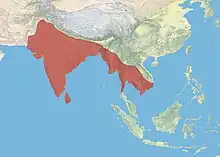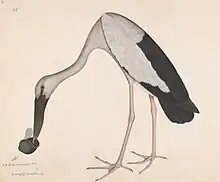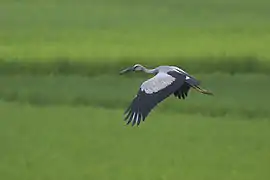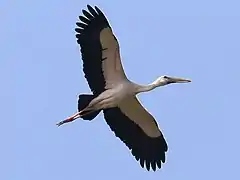Asian openbill
The Asian openbill or Asian openbill stork (Anastomus oscitans) is a large wading bird in the stork family Ciconiidae. This distinctive stork is found mainly in the Indian subcontinent and Southeast Asia. It is greyish or white with glossy black wings and tail and the adults have a gap between the arched upper mandible and recurved lower mandible. Young birds are born without this gap which is thought to be an adaptation that aids in the handling of snails, their main prey. Although resident within their range, they make long distance movements in response to weather and food availability.
| Asian openbill | |
|---|---|
_by_Shantanu_Kuveskar.jpg.webp) | |
| Pair (India) | |
| Scientific classification | |
| Domain: | Eukaryota |
| Kingdom: | Animalia |
| Phylum: | Chordata |
| Clade: | Dinosauria |
| Class: | Aves |
| Order: | Ciconiiformes |
| Family: | Ciconiidae |
| Genus: | Anastomus |
| Species: | A. oscitans |
| Binomial name | |
| Anastomus oscitans (Boddaert, 1783) | |
 | |
| range | |
Taxonomy

The Asian openbill was described by the French polymath Georges-Louis Leclerc, Comte de Buffon in 1780 in his Histoire Naturelle des Oiseaux from a specimen collected in Pondichery, India.[2] The bird was also illustrated in a hand-coloured plate engraved by François-Nicolas Martinet in the Planches Enluminées D'Histoire Naturelle which was produced under the supervision of Edme-Louis Daubenton to accompany Buffon's text.[3] Neither the plate caption nor Buffon's description included a scientific name but in 1783 the Dutch naturalist Pieter Boddaert coined the binomial name Ardea oscitans in his catalogue of the Planches Enluminées.[4] The Asian openbill is now placed in the genus Anastomus that was erected by the French naturalist Pierre Bonnaterre in 1791.[5][6] The genus name Anastomus is from the Ancient Greek αναστομοω anastomoō meaning "to furnish with a mouth" or "with mouth wide-opened". The specific epithet oscitans is the Latin word for "yawning".[7]
Description
The Asian openbill stork is predominantly greyish (non-breeding season) or white (breeding season) with glossy black wings and tail that have a green or purple sheen. The name is derived from the distinctive gap formed between the recurved lower and arched upper mandible of the beak in adult birds. Young birds do not have this gap. The cutting edges of the mandible have a fine brush like structure that is thought to give them better grip on the shells of snails.[8] The tail consists of twelve feathers and the preen gland has a tuft.[9] The mantle is black and the bill is horn-grey. At a distance, they can appear somewhat like a white stork or Oriental stork. The short legs are pinkish to grey, reddish prior to breeding. Non-breeding birds have a smoky grey wings and back instead of white. Young birds are brownish-grey and have a brownish mantle. Like other storks, the Asian openbill is a broad-winged soaring bird, which relies on moving between thermals of hot air for sustained flight. They are usually found in flocks but single birds are not uncommon. Like all storks, it flies with its neck outstretched. It is relatively small for a stork and stands at 68 cm height (81 cm long).[10][11][12]
_by_Shantanu_Kuveskar.jpg.webp) Holding a snail
Holding a snail In flight over marsh habitat
In flight over marsh habitat In flight from below, Thailand
In flight from below, Thailand
Habitat and distribution
The usual foraging habitats are inland wetlands and are only rarely seen along river banks and tidal flats. On agricultural landscapes, birds forage in crop fields, irrigation canals, and in seasonal marshes.[13] Birds may move widely in response to habitat conditions. Young birds also disperse widely after fledging. Individuals ringed at Bharatpur in India have been recovered 800 km east and a bird ringed in Thailand has been recovered 1500 km west in Bangladesh.[10][14] Storks are regularly disoriented by lighthouses along the southeast coast of India on overcast nights between August and September.[10] The species is very rare in the Sind and Punjab regions of Pakistan, but widespread and common in India, Sri Lanka, Nepal, Bangladesh, Myanmar, Thailand and Cambodia.[15] It has recently expanded its range into southwestern China.[16]
Food and foraging
_in_Uppalpadu%252C_AP_W_IMG_2767.jpg.webp)
During the warmer part of the day, Asian openbills soar on thermals and have a habit of descending rapidly into their feeding areas. Groups may forage together in close proximity in shallow water or marshy ground on which they may walk with a slow and steady gait. The Asian openbill feeds mainly on large molluscs, especially Pila species, and they separate the shell from the body of the snail using the tip of the beak. The tip of the lower mandible of the beak is often twisted to the right. This tip is inserted into the opening of the snail and the body is extracted with the bill still under water. Jerdon noted that they were able to capture snails even when blindfolded. The exact action being difficult to see, led to considerable speculation on the method used. Sir Julian Huxley examined the evidence from specimens and literature and came to the conclusion that the bill gap was used like a nutcracker. He held the rough edges of the bill as being the result of wear and tear from such actions.[17] Subsequent studies have dismissed this idea and the rough edge of the bill has been suggested as being an adaptation to help handle hard and slippery shells.[8][18] They forage for prey by holding their bill tips slightly apart and make rapid vertical jabs in shallow water often with the head and neck partially submerged. The gap in the bill is not used for handling snail shells and forms only with age. Young birds that lack a gap are still able to forage on snails. It has been suggested that the gap allows the tips to strike at a greater angle to increases the force that the tips can apply on snail shells. Smaller snails are often swallowed whole or crushed.[18] They also feed on water snakes, frogs and large insects.[19] When foraging on agricultural landscapes with a variety of habitats, Asian openbills preferentially use natural marshes and lakes (especially in the monsoon and winter), and irrigation canals (especially in the summer) as foraging habitat.[13]
Breeding
_juvenile_on_right.jpg.webp)
The breeding season is after the rains, during July to September in northern India and Nepal, and November to March in southern India and Sri Lanka.[13] They may skip breeding in drought years. The Asian openbill breeds colonially, building a rough platform of sticks often on half-submerged trees (often Barringtonia, Avicennia and Acacia species), typically laying two to four eggs. The nesting trees are either shared with those of egrets, cormorants and darters, or can be single-species colonies like in lowland Nepal.[20] Nesting colonies are sometimes in highly disturbed areas such as inside villages and on trees located in crop fields.[21][13] In lowland Nepal, 13 colonies found in an agricultural landscape had an average colony size of 52, ranging from 5 nests to 130 nests.[13] The majority of these colonies were located on Bombax ceiba trees, with much fewer located on Ficus religiosa and Dalbergia sissoo tree species. Asian openbills preferred trees that were much taller and bigger than trees that were available on the landscape, and selectively used wild and native tree species entirely avoiding species that were important for resources such as fruits (e.g. Mangifera indica) despite such trees being much more common.[22] Religious beliefs have secured important trees such as Ficus species, and agro-forestry has secured the most preferred species, Bombax ceiba, that Asian openbills prefer to locate colonies in lowland Nepal.[22] The nests are close to each other leading to considerable aggressive interactions between birds on neighbouring nests. Both parents take turns in incubation, the eggs hatching after about 25 days. The chicks emerge with cream coloured down and are shaded by the loosely outspread and drooped wings of a parent.[10]

Initiation of nests in lowland Nepal was highly synchronized, with colonies started during July and August. Breeding success at nests in these colonies was impacted by proximity of colonies to human habitation, and the progression of the breeding season.[23] Colonies closer to human habitation had lower success, and colonies initiated later during the breeding season (when flooding of the rice fields had reduced to allow ripening of the crop) had lower success. Number of chicks that fledged from colonies located on trees in agricultural landscapes in lowland Nepal were similar to that observed in a protected, mangrove reserve in eastern India suggesting that agricultural areas are not always detrimental to large waterbirds such as Asian openbills.[23]
Nesting openbills in Nepal took an average of 27 minutes to return to nests with food for nestlings and fledglings.[20] The time taken to find food was most impacted by the location of wetlands around colonies, and the progression of the breeding season. Adults look the least time to return with food earlier in the season when the dominant rice crop was most flooded, and time increased as the rice ripened along with the drying out of the fields.[20]
Like other storks, they are silent except for clattering produced by the striking of the male's bill against that of the female during copulation. They also produce low honking notes accompanied by up and down movements of the bill when greeting a partner arriving at the nest.[15][24][25] Males may sometimes form polygynous associations, typically with two females which may lay their eggs in the same nest.[26]
Relationship with other organisms
Young birds at the nest are sometimes preyed on by imperial, steppe and greater spotted eagles.[27] Chaunocephalus ferox, an intestinal parasite, is a trematode worm found in about 80% of the wild populations in Thailand[28] while another species Echinoparyphium oscitansi has been described from Asian openbills in Thailand.[29] Other helminth parasites such as Thapariella anastomusa, T. oesophagiala and T. udaipurensis have been described from the oesophagus of storks.[30][31]
In colonial India, sportsmen shot the openbill for meat, calling it the "beef-steak bird" (although this name was also used for the woolly-necked stork[32]).[33]
References
- BirdLife International (2016). "Anastomus oscitans". IUCN Red List of Threatened Species. 2016: e.T22697661A93628985. doi:10.2305/IUCN.UK.2016-3.RLTS.T22697661A93628985.en. Retrieved 19 November 2021.
- Buffon, Georges-Louis Leclerc de (1780). "Le bec-ouvert". Histoire Naturelle des Oiseaux (in French). Vol. 14. Paris: De L'Imprimerie Royale. pp. 147–149.
- Buffon, Georges-Louis Leclerc de; Martinet, François-Nicolas; Daubenton, Edme-Louis; Daubenton, Louis-Jean-Marie (1765–1783). "Le bec ouvert de Pondichery". Planches Enluminées D'Histoire Naturelle. Vol. 10. Paris: De L'Imprimerie Royale. Plate 932.
- Boddaert, Pieter (1783). Table des planches enluminéez d'histoire naturelle de M. D'Aubenton : avec les denominations de M.M. de Buffon, Brisson, Edwards, Linnaeus et Latham, precedé d'une notice des principaux ouvrages zoologiques enluminés (in French). Utrecht. p. 55, Number 932.
- Bonnaterre, Pierre Joseph; Vieillot, Louis Pierre (1823). Tableau encyclopédique et méthodique des trois règnes de la nature: Ornithologie (in French). Vol. Part 1. Paris: Panckoucke. p. xciii. Although the title page bears the date of 1823 the section (livraison) containing the description was published in 1791. See: Dickinson, E.C.; Overstreet, L.K.; Dowsett, R.J.; Bruce, M.D. (2011). Priority! The Dating of Scientific Names in Ornithology: a Directory to the literature and its reviewers. Northampton, UK: Aves Press. p. 78. ISBN 978-0-9568611-1-5.
- Gill, Frank; Donsker, David, eds. (2019). "Storks, frigatebirds, boobies, cormorants, darters". World Bird List Version 9.2. International Ornithologists' Union. Retrieved 16 July 2019.
- Jobling, James A. (2010). The Helm Dictionary of Scientific Bird Names. London: Christopher Helm. pp. 46, 286. ISBN 978-1-4081-2501-4.
- Gosner KL (1993). "Scopate tomia: an adaptation for handling hard-shelled prey?" (PDF). Wilson Bulletin. 105 (2): 316–324.
- Beddard, F.E. (1901). "Some Notes upon the Anatomy and Systematic Position of the Ciconiine Genus Anastomus". Proceedings of the Zoological Society of London. 70 (1): 365–371. doi:10.1111/j.1469-7998.1901.tb08551.x.
- Ali S, Ripley SD (1978). Handbook of the Birds of India and Pakistan. Volume 1 (2nd ed.). New Delhi: Oxford University Press. pp. 95–98.
- Baker, ECS (1929). The Fauna of British India. Birds. Volume 6 (2nd ed.). London: Taylor and Francis. pp. 333–334.
- Blanford WT (1898). The Fauna of British India. Birds. Volume 4. London: Taylor and Francis. pp. 377–378.
- Sundar, K. S. Gopi (2006). "Flock Size, Density and Habitat Selection of Four Large Waterbirds Species in an Agricultural Landscape in Uttar Pradesh, India: Implications for Management". Waterbirds: The International Journal of Waterbird Biology. 29 (3): 365–374. JSTOR 4132592.
- Ali, Salim (1959). "Local movements of resident waterbirds". J. Bombay Nat. Hist. Soc. 56 (2): 346–347.
- Rasmussen PC, Anderton JC (2005). Birds of South Asia. The Ripley Guide. Volume 2. Washington DC and Barcelona: Smithsonian Institution and Lynx Edicions. p. 63.
- Liu & Buzzard, Paul & Luo, Xu. (2015). Rapid range expansion of Asian Openbill Anastomus oscitans in China. Forktail. 31. 141-143.
- Huxley, J (1960). "The openbill's open bill: a teleonomic enquiry". Zoologische Jahrbücher. Abteilung für Systematik, Ökologie und Geographie der Tiere. 88: 9–30.
- Kahl MP (1971). "Food and feeding behavior of Openbill Storks". Journal of Ornithology. 112 (1): 21–35. doi:10.1007/BF01644077. S2CID 1484358.
- Mukherjee, Ajit Kumar (1974). "Food-habits of water-birds of the Sundarban, 24 Parganas District, West Bengal, India-IV. Stork, Teal, Moorhen and Coot". J. Bombay Nat. Hist. Soc. 71 (2): 188–200.
- Sundar, K. S. Gopi; Maharjan, Bijay; Koju, Roshila; Kittur, Swati; Gosai, Kamal Raj (2016). "Factors Affecting Provisioning Times of Two Stork Species in Lowland Nepal". Waterbirds. 39 (4): 365–374. doi:10.1675/063.039.0406.
- Datta T, Pal BC (1993). "The effect of human interference on the nesting of the openbill stork Anastomus oscitans at the Raiganj wildlife sanctuary, India". Biological Conservation. 64 (2): 149–154. doi:10.1016/0006-3207(93)90651-G.
- Koju, Roshila; Maharjan, Bijay; Gosai, K.R.; Kittur, Swati; Sundar, K.S. Gopi (2020). "Ciconiiformes nesting on trees in cereal-dominated farmlands: the importance of scattered trees for heronries in lowland Nepal". Waterbirds. 42 (4): 355–365. doi:10.1675/063.042.0401. S2CID 210861485.
- Sundar, K.S. Gopi; Koju, Roshila; Maharjan, Bijay; Marcot, Bruce G.; Kittur, Swati; Gosai; Kamal Raj (2019). "First assessment of factors affecting the breeding success of two stork species in lowland Nepal using Bayesian Network models". Wildfowl. 69: 45–69.
- Kahl, M Philip (1970). "Observations on the breeding of Storks in India and Ceylon". J. Bombay Nat. Hist. Soc. 67 (3): 453–461.
- Mukhopadhyay, Anand (1980). "Some observations on the biology of the Openbill Stork, Anastomus oscitans (Boddaert), in southern Bengal". J. Bombay Nat. Hist. Soc. 77 (1): 133–137.
- Datta T, Pal BC (1995). "Polygyny in the Asian Openbill (Anastomus oscitans)" (PDF). The Auk. 112 (1): 257–260. doi:10.2307/4088788. JSTOR 4088788.
- Naoroji, Rishad (1990). "Predation by Aquila Eagles on nestling Storks and Herons in Keoladeo National Park, Bharatpur". J. Bombay Nat. Hist. Soc. 87 (1): 37–46.
- Poonswad P; Chatikavanij P & Thamavit W (1992). "Chaunocephalosis in a wild population of Asian open-billed storks in Thailand". Journal of Wildlife Diseases. 28 (3): 460–466. doi:10.7589/0090-3558-28.3.460. PMID 1512882. S2CID 6110958.
- Poonswad P, Chatikavanij P (1989). "Echinoparyphium oscitansi n. sp. (Trematoda: Echinostomatidae): Natural infection in Asian Open-billed Storks (Anastomus oscitans; Aves; Ciconiidae) in Thailand" (PDF). J. Sci. Soc. Thailand. 15 (4): 293–299. doi:10.2306/scienceasia1513-1874.1989.15.293.
- Gupta AN, Sharma PN (1970). "Histological and histochemical studies of a new species of Thapariella (Trematoda: Digenea)". Rivista di Parassitologia. 31 (3): 169–174. PMID 5498221.
- Ramanaiah BV, Agarwal SM (1970). "Thapariella oesophagiala sp. novo. (Trematoda: Thapariellidae)". Indian Journal of Helminthology. 21 (2): 115–118.
- Jerdon, T.C. (1864). The Birds of India. Volume III. London: George Wyman and Co. p. 738.
- Finn, Frank (1906). How to the know the Indian waders. Calcutta: Thacker, Spink and Co. p. 20.
External links
- Asian Openbill (Anastomus oscitans) video photos and sounds - Internet Bird Collection
- Asian Openbill Anastomus oscitans - Adult Archived 2020-06-05 at the Wayback Machine - Oriental Bird Images
